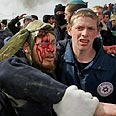
Violence at Amona
צילום: רויטרס
The end of religious Zionism
When rabbis send their flock to hit and be hit, it's time for a change
"The king has no clothes," screams the child at the end of Anderson's well-known tale, "The King's New Clothes."
The sight of teenagers at Amona, the "quality" kids who have been told for months on end to become cannon fodder for the cameras to bring out a little empathy for the cause, must scream out to the religious-Zionist community: The king has no clothes.
Religious Zionism has gone bankrupt, for all to see and on national television. Some contenders were dying out anyway, but this fact doesn't change the end result, appalling and humiliating as it was for both sides.
Extreme Zionism
For decades, religious Zionism has grown evermore extreme – politically and religiously.
It is like longtime National Religious Party Chairman Yosef Burg never existed. It's like the beginning of the Book of Exodus – there's a new king in town, a new leadership, one that never knew (Prof.) Yosef.
The event at Amona brought out several important facts: First, that religious Zionism is no longer a single homogeneous group – the relative minority of law breakers at the outpost attests to this fact.
Many teenagers filled up Amona, but many more never showed up. Religious Zionism is crumbling. There are many streams within it, with more dividing them than uniting them.
Not Zionist, not religious
The law breakers, the "Hebronites" or "Amona-ites" may consider themselves connected to religious Zionism, and may even be considered by the public at large as such.
But they can no longer reasonably be called "Zionists", not even "religious." They separated themselves from religious Zionism and created a new radical stream, similar to the Sicarii that took over the Jewish people during the second temple period (and were the catalysts for that destruction).
The second fact, that influences and is influenced by the first, is that today's religious Zionism has no leaders. There is no power leading it or determining the path it will take.
The cement and mortar of Judean and Samarian hilltops have taken over the religious-Zionist vision and pushed aside the values that defined the movement in the past (does anybody still remember "The Torah's ways are ways of peace?")
Crumbling vision
This vision has once again crumbled, this time in Amona, with the use of shocking violence on the part of teenagers and security forces.
The leadership is divided and crumbling. On one hand of the barricade are extremist rabbis, preaching their political beliefs to excited and excitable young people under the guise of "Torah," just like in ultra-Orthodox circles.
The same rabbis and teachers who send their disciples – for reasons of convenience or to create a community of admirers – in front of the TV cameras, to take and give out a few punches.
Death of moderation
In order to understand that the youth did not initiate the struggle at Amona, it is enough to look at the religious-right wing media that incited and continues to incite its public with encouragement from rabbis and teachers.
On the other side of the same leadership is the so-called "moderate" National Religious Party and the remnants of Meimad, both of which are breathing their last breaths.
The National Religious Party is dying because it has been moved rightward to satisfy a public it hasn't really had for years, while ignoring the deafening roar of religious Zionists that have already defected to Kadima.
And Meimad? It's condition is comparable to the current state of Prime Minister Sharon.
Frightened silence
Religious Zionism is crumbling before our very eyes and under withering, unprecedented criticism from the outside.
Politicians, authors, and other public figures – some out of concern, some out of contempt – will do nothing to save it.
But from within there is no shortage of pragmatic, moderate rabbis and educators, but nearly all have remained silent, petrified to criticize, fearful of criticism from their communities or families, or of the image their yeshivas will have if they dare criticize Rabbis Shapira and Eliyahu.
It is time for the remnants of religious Zionism to stand up and disconnect itself from the Sicarii camp who have stopped stopping for hitchhiking soldiers and refuse to count those in uniform for a minyan.
If this is not done – it will disappear.
The future of religious Zionism is now on the chopping block. These battles could lead to destruction or to new growth – the choice is in our hands.
Shai Binyamini is the chairman of the Realistic Religious Zionist movement










